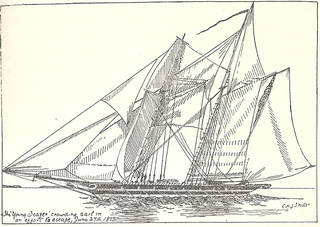See also
- HMS Severn - one of nine ships of the Royal Navy
- USS Severn - one of four ships of the United States Navy
- SS Severn River
- Severn-class lifeboat
Several ships have been named Severn for the River Severn:

Joseph Barss was a sea captain of the schooner Liverpool Packet and was one of the most successful privateers on the North American Atlantic coast during the War of 1812.
Sir John Sherbrooke was a successful and famous Nova Scotian privateer brig during the War of 1812, the largest privateer from Atlantic Canada during the war. In addition to preying on American merchant ships, she also defended Nova Scotian waters during the war. After her conversion to a merchantman she fell prey to an American privateer in 1814. She was burnt to prevent her reuse.

HMS Fantome was an 18-gun brig-sloop of the Royal Navy. She was originally a French privateer brig named Fantôme, which the British captured in 1810 and commissioned into British service. Fantome saw extensive action in the War of 1812 until she was lost in a shipwreck at Prospect, Nova Scotia, near Halifax in 1814.

HMS Belvidera was a Royal Navy 36-gun Apollo-class frigate built in Deptford in 1809. She saw action in the Napoleonic Wars and the War of 1812 and continued a busy career at sea into the middle of the 19th century. In 1846 she was reduced to harbour service, in 1860 she became a receiving ship, and she was finally disposed of in 1906.
Liverpool Packet was originally the American slave ship Severn, built at Baltimore and captured in 1811. She became a privateer schooner from Liverpool, Nova Scotia, that captured 50 American vessels in the War of 1812. American privateers captured Liverpool Packet in 1813, but she failed to take any prizes during the four months before she was recaptured. She was repurchased by her original Nova Scotia owners and returned to raiding American commerce. Liverpool Packet was the most successful privateer vessel ever to sail out of a Canadian port.
Ten ships of the Royal Navy have borne the name HMS Magnet:

Young Teazer was a United States privateer schooner that captured 12 British vessels, five of which made it to American ports. A member of her crew blew her up at Mahone Bay, Nova Scotia during the War of 1812 after a series of British warships chased her and after HMS Hogue trapped her. The schooner became famous for this deadly explosion, which killed most of her crew, and for the folklore about the ghostly "Teazer Light."

HMS Epervier was an 18-gun Cruizer-class brig-sloop of the Royal Navy, built by Ross at Rochester, England, and launched on 2 December 1812. USS Peacock captured her in 1814 and took her into service. USS Epervier disappeared in 1815 while carrying dispatches reporting the signing of a treaty with the Dey of Algiers.
HMS Chub was a British Royal Navy Ballahoo-class schooner of four 12-pounder carronades and a crew of 20. The prime contractor for the vessel was Goodrich & Co., in Bermuda, and she was launched in 1807. She and her crew were lost when she was wrecked in August 1812.
HMS Curlew (1812) was a Royal Navy Cruizer class brig-sloop built by (William) Good & Co., at Bridport and launched in 1812. She served with the Navy for only 10 years. During the War of 1812 she sailed from Halifax and captured several American privateers. Her greatest moment was her role in the 1819 British occupation of Ras Al Khaimah, leading to the signature of the General Maritime Treaty of 1820, which established the Trucial States, today the United Arab Emirates. Curlew was sold in 1822 in Bombay. She then had a 13 or so year career as an opium runner for James Matheson, one of the founders of the firm Jardine Matheson.

Rossie was a schooner launched at Baltimore in 1807. At the outbreak of the War of 1812 she became a privateer, operating under a letter of marque. She made two voyages, the first as a privateer, and the less successful second as a letter of marque. The British captured her in January 1813.
A number of vessels have been named Alexander:
Several ships have been named Princess Amelia:
Several vessels have been named Harriet, or Harriot:

HMS Pyramus was a fifth-rate 36-gun frigate launched at Portsmouth in 1810. During the Napoleonic Wars she captured some small privateers. She was hulked in 1832–1833 at Halifax, Nova Scotia. The vessel was sold and broken up in 1879.
Invincible Napoleon was a three-masted French privateer commissioned in Bayonne in Spring 1804. She made numerous cruises until 1813–1814 when the British and the Americans repeatedly captured her. In her brief career as an American privateer she captured some 14 vessels. She finally ended up in British hands and was taken to Halifax, Nova Scotia as a prize.
Several vessels have been named Recovery:
Several ships have been named Swallow for the bird Swallow:
Ann was launched in America in 1800, possibly under another name. She transferred to the United Kingdom in 1805. Between 1810 and 1813 she became a temporary packet operating out of Falmouth, Cornwall for the Post Office Packet Service. American privateers twice captured her in 1813 in single ship actions.
Several vessels have been named Liverpool Packet: